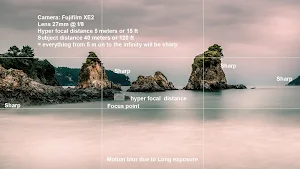"Al Cabri: Focus & Depth of Field – The Art of Sharpening Vision in Photography"
Image captured with a Nikon FM 3 an 85mm f/1.4 Nikkor lens on Agfa Scala B&W slide film.
Focus point is on her right eye at f/1.4, the scale at the lens shows a distance of 30 cm to be in focus at a shooting distance of 3 meters approx.. Note the shoulder is blurred at the front but the area close to her face is sharp so as her hair in the front, that forms the sharp area within 30 cm. 1 foot.
From mid head onto the background everything's blurred producing a creamy bokeh effect obtained when using very shallow DoF, f numbers from .85 to 2.8 often found on prime fixed length lenses, and may be achieved using large telephotos at f/4, say a 200mm f/4 and a short distance to the subject.
Not only the f number matters, distance to the subject is as important. You may achieve a similar result using a kit lens with f/4 shooting at close range to your subject, it may not look as exaggerated as the result of the prime lens but you'll get the effect.
Focus and depth of field are crucial aspects of photography that directly impact the visual aesthetics and storytelling potential of your images. Now we'll delve into the importance of focusing accurately on your subject and how manipulating depth of field can be used creatively to either isolate your subject or create a sense of depth in your photographs.
1. Accurate Focusing:
Precise focusing is paramount in photography because it defines what will be sharp and in focus in your image. Here's why accurate focusing is essential:
Clarity and Sharpness: Accurate focusing ensures that the subject or the intended point of interest is sharp and well-defined, which is especially crucial in portrait, macro, and product photography.
Reducing Distractions: It helps eliminate distractions in the background, keeping the viewer's attention on the subject.
Telling a Story: By controlling what's in focus, you can guide the viewer's eye and convey a specific narrative or emotion. For example, focusing on a person's eyes in a portrait can create a strong emotional connection with the viewer.
Creativity: Precise focusing allows you to experiment with shallow depth of field for artistic and creative effects.
2. Depth of Field ( DoF )
Depth of field refers to the area in front of and behind the focused point that appears acceptably sharp in an image. Understanding and controlling DoF is a powerful tool for photographers.
Here's how depth of field can be creatively employed:
Shallow DoF: When you use a wide aperture ( e.g., f/1.2, f/1.4 or so ), you create a shallow depth of field. This means that only a small portion of your image is in sharp focus, while the rest becomes beautifully blurred.
This technique is often used in portrait and macro photography to isolate the subject from distracting backgrounds.
Bokeh Effect: The pleasing, creamy background blur created by shallow DoF is known as bokeh. It can add a sense of magic and enchantment to your images, making them more visually appealing.
Deep DoF: Conversely, a narrow aperture (e.g., f/8 - f/22) increases depth of field, making more of the image appear sharp. This technique is commonly used in landscape photography to keep everything in the frame, from the foreground to the background, in focus.
Tip. Beware that when going above f/11 the risk of having dirt or dust particles on your images will increase significantly, make sure your lenses are spotless clean when going around this apertures otherwise your images will be ruined or you'll get to spend hours retouching unwanted dust or dirt particles on them, other considerations to take into account are deformation and lens vignetting. As for me, I never go above f/11, controlling the distances of your subjects or landscapes will help you avoiding this risks, having a small manual blower at all times will be very useful as there are particles that will stick to your lens at all times regardless of where you are, specially if you are shooting outdoors.
Layering and Depth: Using DoF strategically, you can create layers within your image, giving it a sense of depth and dimension. This technique is especially powerful in street or environmental portrait photography.
Foreground and Background Relationships: DoF allows you to control how the foreground, subject, and background relate to one another in your composition. For example, a narrow DoF can make a subject pop against a blurred background.
In summary, understanding and mastering focus and depth of field are essential skills for any photographer. They provide you with the creative tools to control what's emphasized in your images and how you guide the viewer's eye through your visual stories. Whether you're aiming to isolate a subject, create a dreamy atmosphere, or add depth to your compositions, precise focusing and thoughtful depth of field management are your keys to photographic excellence
The Hyperfocal technique is the best tool to control what you have or not in focus, most cameras have a scale to know exactly what your focus area is. Use it and see the big difference.
Take into account that large sensors produce a shallower depth of field than the smaller ones, it really depends on the result you are trying to achieve, make sure to go over my posts more more examples and further info on this topic. I do have a YouTube video extensively covering this subject, pay a visit to my channel and learn how to master depth of field in photography, a very useful tool for the craft!
Copy & paste on your browser, subscribe to be part of the growing community! https://www.youtube.com/@alcabriphotography
Happy Shooting! Al Cabri.






Comments
Post a Comment